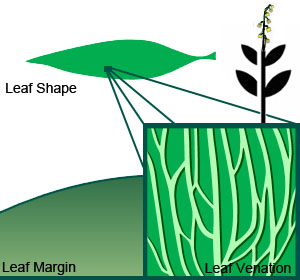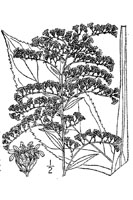
Early goldenrod is a member of the goldenrod, solidago, family that includes 100 to 120 known species of plants. The many goldenrod species can be difficult to distinguish, due to their similar bright, golden yellow flower heads that bloom from July until September. Early goldenrod, along with other species in this family, is often unfairly blamed for causing hay fever in humans. The pollen causing these allergy problems is mainly produced by ragweed which blooms at the same time as the goldenrod. However; Goldenrod is pollinated by insects and ragweed is pollinated by the wind. Goldenrods are, in some places, held as a sign of good luck or good fortune. They are considered weeds by many in North America but they are prized as garden plants in Europe, where British gardeners adopted goldenrod long before Americans did as garden subjects. Goldenrod species are used as a food source by the larvae of many Lepidoptera species. The invading larva may induce the plant to form a bulbous tissue mass called a gall around it, upon which the larva then feeds. Various parasitoid wasps find these galls and lay eggs in the larvae, penetrating the bulb with their ovipositors. Woodpeckers are known to peck open the galls and eat the insects in the centre.
Goldenrod can be used as a source of rubber. However; the rubber lacks tensile strength. Commercially goldenrod tea can be found in many health stores.
Within the realm of rational and holistic medicine, members of the solidago family have been used in a traditional kidney tonic by practitioners of herbal medicine to counter inflammation and irritation caused of bacterial infections or kidney stones. Goldenrod has also been used as part of a tincture to aid in the cleansing of the kidney or bladder during a healing fast, in conjunction with potassium broth and specific juices. Native Americans chewed the leaves to relieve sore throats and chewed the roots to relieve toothaches.
Please note that MIROFOSS does not suggest in any way that plants should be used in place of proper medical and psychological care. This information is provided here as a reference only.
Early goldenrod is considered edible. Native Americans used the seeds of some species for food. Teas are sometimes made with goldenrod. Honey from goldenrods often is dark and strong due to admixtures of other nectars.

Early goldenrod is un branched and grows up to 90cm tall. The central stem is slightly ridged, hairless, and green or reddish. The alternate lanceolate leaves are up to 20cm long and 3cm across, becoming much smaller as they ascend up the stem. The margins are entire (smooth) or slightly serrated. Sometimes there are tiny hairs along the margins, otherwise the leaves are hairless. The inflorescence occurs at the apex of the plant, and consists of a panicle of flowering stems that often arch upward and outward like a fireworks display. There are numerous yellow composite flowers, each about 5mm to 10mm across. From 4 to 12 ray florets can be observed around the disk florets, often unevenly spaced and not open at the same time. The flowers may have a mild fragrance. The blooming period occurs during mid- to late summer, and lasts about 1 to 2 months. Later, the achenes develop with small tufts of hair, which are dispersed by wind. The root system consists of a short caudex (on old plants), which may produce rhizomes and vegetative offshoots.
| Plant Height |
60cm to 90cm |
| Habitat |
Fields, Roadsides, Waste places |
| Leaves |
Lanceolate |
 |
| Leaf Margin |
Entire |
| Leaf Venation |
Longitudinal |
| Stems |
Smooth Stems |
| Flowering Season |
July to September |
| Flower Type |
Elongated clusters of bell shaped florets |
| Flower Colour |
Yellow |
| Pollination |
Bees, Insects |
| Flower Gender |
lowers are hermaphrodite and the plants are self-fertile |
| Fruit |
Tufted Seeds |
| USDA Zone |
3A (-37.3°C to -39.9°C) cold weather limit |
No known health risks have been associated with early goldenrod. However ingestion of naturally occurring plants without proper identification is not recommended.
 |
-Click here- or on the thumbnail image to see an artist rendering, from The United States Department of Agriculture, of early goldenrod. (This image will open in a new browser tab) |
 |
-Click here- or on the thumbnail image to see a magnified view, from The United States Department of Agriculture, of the seeds created by early goldenrod for propagation. (This image will open in a new browser tab) |
Early goldenrod can be referenced in certain current and historical texts under the following three names:
Early Goldenrod can be translated into the following select languages:
| Arabic |
غولدينرود |
Bulgarian |
златна |
Chinese (Sim) |
黄花 |
| Croatian |
|
Czech |
zlatobýl |
Danish |
Gyldenris |
| Dutch |
guldenroede |
Esperanto |
|
Estonian |
kuldvits |
| Finnish |
|
French |
verge d'or |
German |
Goldrute |
| Greek |
χρυσόβεργα |
Hebrew |
שבט זהב |
Hungarian |
aranyvessző |
| Italian |
verga d'oro |
Japanese |
アキノキリンソウ |
Korean |
조색 |
| Low Saxon |
|
Lithuanian |
|
Norwegian |
oker |
| Persian |
طلا |
Polish |
nawłoć |
Portuguese |
|
| Romanian |
splinuta |
Russian |
золотарник |
Slovak |
zlatobyľ |
| Spanish |
vara de oro |
Swedish |
gullris |
Tagalog |
|
| Turkish |
altın başak |
Ukrainian |
золотушник |
Vietnamese |
|
| The information provided in this conservation assessment has been provided by the Natureserve Database in conjunction with various federal, provincial, state, county, district, regional, and municipal governments as well as public and private conservation authorities. Information in this section is accurate from the last time this article was updated. |
 |
Early goldenrod is apparently secure in North America. However, many local authorities within the growing range of early goldenrod have not submitted tracking data for the species. |
 |
The MIROFOSS database offers free printable garden tags for personal and non-profit use. These tags can be used to properly identify plant samples in a garden. Click on the tags shown on the the screen or -click here- to download a full size jpeg image for an early goldenrod identification tag; which can be printed on paper or used with a plastic laser printer. |
 |
What's this?
This is a QR code (short for Quick Response) which gives fast-track access to MIROFOSS articles. QR Codes are barcodes that can be read by smart phone cameras. This QR Code is unique to this MIROFOSS article.
What can I do with it?
You can copy and print the QR code to a plant label, poster, book, web site, magazines, or newspaper so smart phone users can scan the QR Code which automatically takes them to this specific article. |

| Description / Application |
Marshall Cavendish Corporation (2001). Endangered Wildlife and Plants of the World: Fra-Igu. Marshall Cavendish. pp. 632–. ISBN 978-0-7614-7199-8.
|
| Description |
Solidago. Integrated Taxonomic Information System (ITIS) |
| Folklore |
Goldenrod. Complementary and Alternative Medicine Guide. University of Maryland Medical Center. |
| Biology |
Dickinson, R.; Royer, F.; (2014) Plants of Southern Ontario. ISBN 978-1-55105-906-8. |
| Biology |
elitto, L.; Schacht, W. (1995). Hardy Herbaceous Perennials: A-K ; Vol. 2, L-Z. Timber Press. p. 629. ISBN 978-0-88192-159-5. |
| Image Rendering |
USDA-NRCS PLANTS Database / USDA NRCS. Wetland flora: Field office illustrated guide to plant species. USDA Natural Resources Conservation Service. |
| Environment |
National Audubon Society. Field Guide To Wildflowers (Eastern Region): Alfred A. Knopf. ISBN 0-375-40232-2 |
| Physical Identification |
National Audubon Society. Field Guide To Wildflowers (Eastern Region): Alfred A. Knopf. ISBN 0-375-40232-2 |
| June 07, 2015 |
The last time this page was updated |
| ©2021 MIROFOSS™ Foundation |
 |
|
|



















